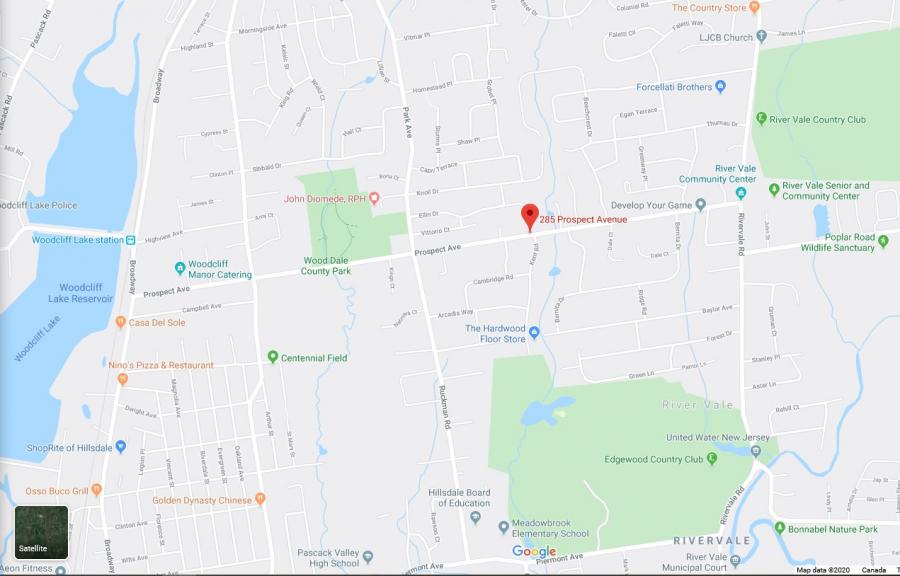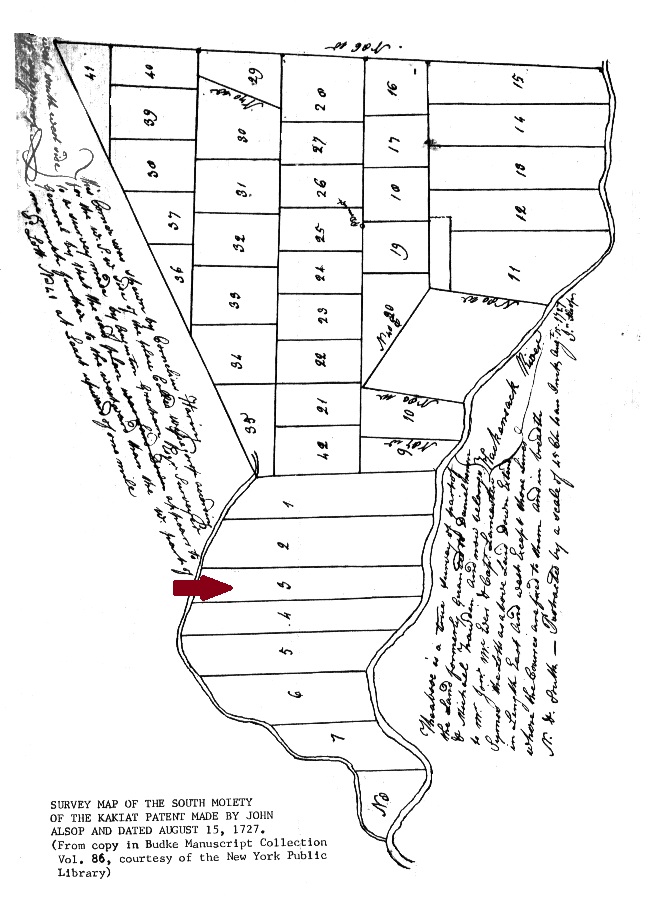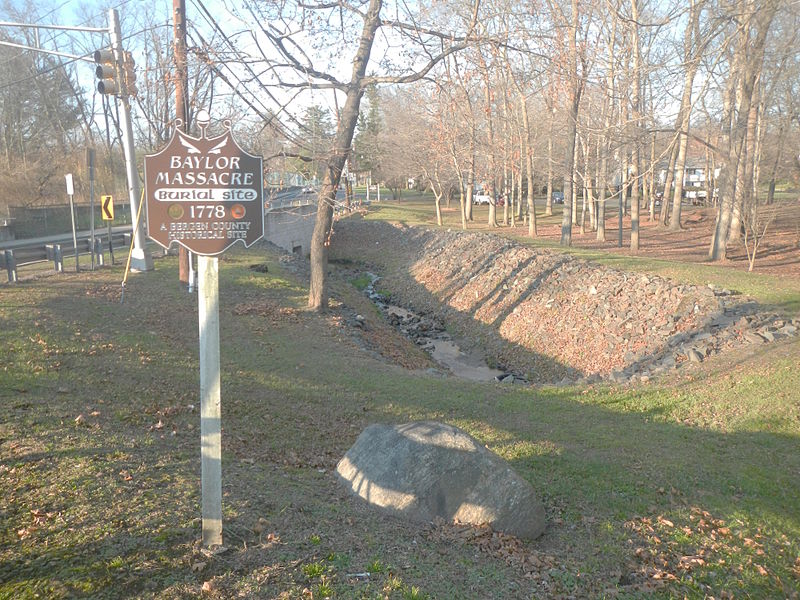Geo-Historical Sleuthing: New Jersey Edition
How do you go about locating where a person lived 240 years ago in a place you’ve never been? This was my situation when I started researching New Brunswick loyalist, Gasper Maybee, who was originally from Bergen County, New Jersey. Through using a series of modern and historical maps, first-hand accounts, and some very helpful local expertise, I was able to pinpoint the area where he grew up and inherited land.
The first step was to make sure I had the correct Gasper Maybee’s place of origin. I quickly found his was a common name in New Jersey and was recorded with many variations, “Casperus Mabie” being the most common version. The original Casperus Mabie was a member of the second generation of Dutch immigrants to settle New Amsterdam, or what would become New York City. The family would eventually move to Bergen County, New Jersey. The names Casper and Pieter are repeated throughout generations and branches of the Mabie/Maybee family.
As with any family research, major caution must be taken in dealing with errors in historical records. Gasper’s parents were Pieter/Peter/Pieterse Mabie Jr. (b. 1717, d. 1797) and Jannetye Hogenkamp (b. 1716). Gasper was likely baptized on February 4, 1750 at the Old Paramus Reformed Church in Paramus, Bergen County, New Jersey with his uncle, Casparus Mabie, as a witness to the event. Probate records are an excellent way to confirm family relationships and Pieter Mabie’s children were listed in his will and in an entry in the New Jersey Orphan Court Books on September 16, 1797 which included the name “Casparus.”
Once I located the correct “Casper Mabie” (1750-1822) who joined the King’s Orange Rangers (a provincial loyalist regiment) by 1777, I still had the challenge of his name being recorded in various versions in military and land documents which were spread along his route during the American Revolution from New Jersey, to New York, Nova Scotia, and finally New Brunswick.
Variety of ways Gasper Maybee’s name was recorded during his time in the King’s Orange Rangers and later in New Brunswick (from British Military and Naval Records and New Brunswick Land Petitions):
Muster roll for the King’s Orange Rangers, April 1778 – “Casperius Maybee”
Muster roll for the King’s Orange Rangers, August 1778—“Cuspar Maybee”
Muster roll for the King’s Orange Rangers, February 1778—“Casparus Maybee”
Muster roll for the King’s Orange Rangers, Harlem, New York, 1778—“Casparus Mabee”
Muster roll for the King’s Orange Rangers, Paulus Hook, New York, August 1777—“Gasparus Maybee”
Land Petition, New Brunswick, c. 1787--“Gasper Maybea”
Land Petition, New Brunswick, 1800—“Gasper Maybee”
I received some expert local help in New Jersey from a member of the Pascack Historical Society through Francesca M. Moskowitz, Trustee and “PHS Answer Girl.” The landscape and history of land allotment and division is very different in each American state and even county, so this assistance was key. I have often found the advice of someone who is well-versed in the history of a particular area within the United States invaluable in locating the origins of many loyalists who came to Canada. I have been very lucky to have the goodwill of many such helpers in my research.

(Map data ©2020 Canada)
The Mabies lived on property that was originally part of the “Kakiat Patent,” a land grant which ran parallel and north of Prospect Avenue in Park Ridge and very near River Vale, Bergen County, New Jersey, with portions of the land also falling into the boundaries of modern Woodcliff Lake, New Jersey. This area had been referred to as Pascack and would have been called Haring Township (later called Harrington Township) at the time of the American Revolution. Boundaries and communities have changed significantly during the time the Mabies lived in Bergen County, with debate over the New York/ New Jersey border in the area finalized in 1773, making the Mabie’s land which had been in New York State part of New Jersey. The Mabie family, like other families in the area, had strong connections just over the border in New York, particularly in Tappan.

(“South Moiety of the Kakiat Patent,” Credit: Image courtesy of the Tappantown Historical Society)
The Mabie land was located on “Lot 3” of the Kakiat Patent (now mainly in Park Ridge, New Jersey), originally composed of 570 acres divided among three families and then subdivided and sold over the years during the eighteenth and early nineteenth century. The earliest record of Mabie ownership of the land was Gasper’s grandfather, Pieter Mabie Senior, in 1747. He was probably granted the land in 1730 with his share running east to west in long strips between the Hackensack River and Pascack Brook. In his will proved July 8, 1772, Peter Mabie Senior left his son Pieter Junior (Gasper’s father) a parcel of his land, mostly in the west of the original grant. The Mabie land is now bordered by Prospect Avenue on the south side, with Broadway, Kinderkamack Road, Rickman Road, and Rivervale Road running north-south intersecting the property. It was made up of an uncultivated and swampy valley in the west, which would become Gasper’s inherited land, and woods leading to the Pascack Brook.
Starting in about 1759, Pieter Mabie made his family home on the land in Park Ridge and the Mabie homestead likely stood at the northeast corner of Prospect and Park Avenue. The “Mabie-Lockwood House” existed at 285 Prospect Avenue on a part of the land owned by Mindert Mabie (Gasper’s younger brother), bought in 1791 from their father and survived up until the early twenty-first century. Gasper’s older brother, Abraham, had been given three acres of land by Pieter in 1776 and probably erected a house at the location. Due to Abraham being a very active loyalist during the war, he likely gave the land back to his father when he left the area. Abraham also held a possible connection to the events which produced the “Baylor Massacre.”

(Credit: Jim.henderson, Public domain via Wikimedia)
On the night of September 27th/ September 28th, 1778, twelve companies of British light infantry under Major Turner Staubenzie and Colonel John Maitland advanced on the Overkill Road (now Rivervale Road), where they took the 3rd Continental Light Dragoons by surprise as they slept, using bayonets to execute and maim the completely unprepared Continental soldiers. The event would be known as the Baylor Massacre.
Adrian Leiby in The Revolutionary War in the Hackensack Valley suggests that Abraham Mabie, Gasper’s brother, was a strong suspect for one of the individuals who aided the British in this event, but alternate informants have been suggested as well. Around the time of the Baylor Massacre, Abraham became an active spy for the British and eventually a captain in the Associated Loyalists. An interesting notation of the Mabie’s farm was made in the maps created during the British campaign in the Hackensack Valley by the ill-fated Major John André, indicating he thought the family were of importance.

(Credit: “Hackinsack River Valley,” John André, Journal and Maps: 1777-1778, The Huntington Library, HM626)
Another of Gasper’s brothers, Mindert, and father, Pieter, were arrested for harbouring loyalist outlaws in caves they constructed on the family land. They were accused of digging caves on their property, which was somewhat remote being off the main route of Overkill/ Rivervale Road, making it an ideal way station for loyalist gangs. Father and son were probably released in May 1780 and must have halted their activities as the family that remained in New Jersey were able to retain their property though they were known loyalists. During the time of Baylor’s Massacre and the arrest of his brother and father, Gasper was in New York and then Nova Scotia with the loyalist provincial regiment, the King’s Orange Rangers. After the regiment was disbanded in 1783, Gasper was one of the few members to permanently settle on the land granted to the group at Quaco (now St. Martins), New Brunswick.
“Casparus Mabie” (Gasper Maybee) had received lot 4 of his father’s land made up of 7.78 acres on the north line of the farm as his inheritance. Pieter Mabie had made provision in his will knowing some of his children were far away, including Gasper in New Brunswick and Abraham who had migrated to Ontario, to see that they were to be compensated fairly for their shares, but they also needed to get the approval of siblings before selling land. On November 12, 1805 at Saint John, New Brunswick, Canada, Gasper Maybee officially sold his inherited land in Park Ridge, New Jersey, to his brother, Mindert, for $75, closing the bond he had had with his homelands in New Jersey.
Recovering the stories of loyalists through time and space is certainly possible with some local help, the right historical documents, and key secondary sources. The stories that emerge are always surprising and worth the effort!
Keep watching our project site for “New Brunswick Loyalist Journeys” for more on Gasper Maybee’s life.
Leah Grandy holds a PhD in History and works as a Microforms Assistant at the Harriet Irving Library.
Sources
Howard I. Durie, The Kakiat Patent in Bergen County, New Jersey; with genealogical accounts of some of its early settlers (Pearl River, NY: Star Press, 1970).
Adrian C. Leiby, The Revolutionary War in the Hackensack Valley: The Jersey Dutch and the Neutral Ground, 1775-1783 (New Brunswick, New Jersey: Rutgers University Press, 1962).
The Maybe Society website, https://maybeesociety.org .
Robert R. Mutrie, 6000 New York Ancestors: A Compendium of Mabie Research (Toronto, ON: Second Ave. Printing Ltd., 1986).
Howard S.F. Randolf and Russell Bruce Rankin, Paramus, Bergen County, New Jersey, Reformed Dutch Church Baptisms, 1740-1850 (Newark, NJ: Somerset Press, 1935).
Patricia A. Wardell, Bergen County, NJ and Vicinity, Dictionary of Place Names, <http://www.dutchdoorgenealogy.com/>, viewed July 2019.
SUBJECTS: geography, mapping, New Jersey, loyalist, Dutch, Bergen County, local history, espionage, John André



Comments
Peter Johnson (not verified)
Sun, 04/05/2020 - 14:12
Permalink
The Maybees
Fascinating article and especially so for me as a descendant of Capt. Abraham MAYBEE UE brother of Gasper UE.
lgrandy
Mon, 04/06/2020 - 07:51
Permalink
Abraham Maybee
Wonderful! We are always glad to hear from descendants of people we have researched.
Peter Allan (not verified)
Fri, 03/03/2023 - 15:33
Permalink
Pietre Maybee
I am related to the Maybees that eventually settled in Perth County Ontario Canada.
My understanding is that a ship was provided to Transport the loyalists up the St. Lawrence River where they eventually built small craft and sailed and rowed to Lake Ontario to land in Perth County given to them by the king ( British government)
How true is thiis?
lgrandy
Fri, 03/03/2023 - 16:19
Permalink
Pietre Maybee
Thanks very much for your comment! We do not have a wide expertise in the Upper Canadian loyalist experience as we specialize in New Brunswick, but I can suggest contacting an Ontario branch of the United Empire Loyalist Association of Canada: https://uelac.ca/branches/
Add new comment